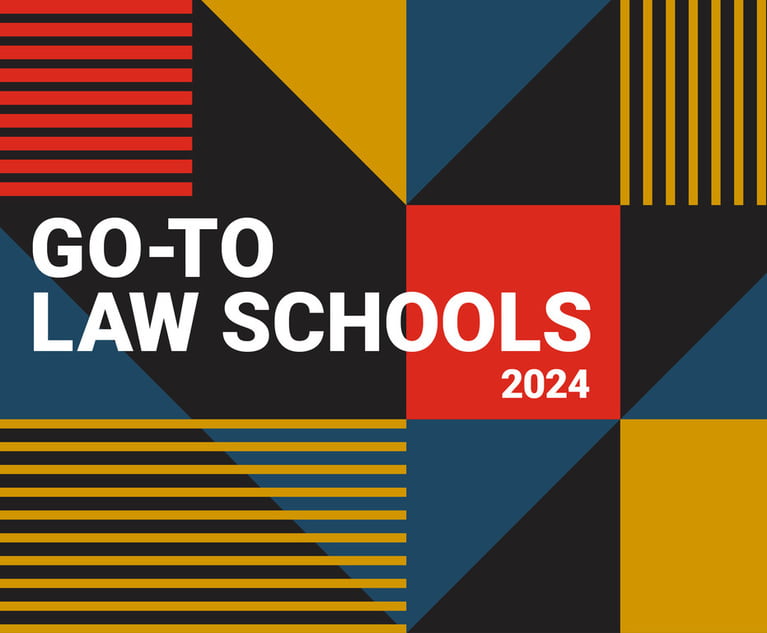Law School Enrollment Edges Up, with Surprise Spike in Non-JD Programs
Enrollment in law school J.D. programs dipped a tad this year, but some unexpected good news provided a counterbalance.While J.D. enrollment…
December 15, 2017 at 03:59 PM
4 minute read
Enrollment in law school J.D. programs dipped a tad this year, but some unexpected good news provided a counterbalance.
While J.D. enrollment fell by 0.7 percent compared with last year, the numbers of non-J.D. students—studying for LL.M., masters or certificate degrees—grew by a whopping 20.5 percent, compared with last year, according to data from the American Bar Association Section of Legal Education and Admissions to the Bar, which accredits U.S. law schools.
That means overall law school enrollment edged up by 1.6 percent to 126,638, which is 2,010 more students than last year. That total is made up of 110,156 J.D. students plus 16,482 non-J.D. students.
As for first-year student enrollment—which schools closely watch since it has financial implications for the next three years—the ABA data released late Thursday shows the number of those students ticked up slightly for the second year in a row. There were 37,398 new first-year students in fall 2017, a gain of 291 students or 0.8 percent compared with last year. This year's increase is small, but it's still greater than the miniscule uptick last year, when only 36 additional first-year students enrolled compared to the previous year.
Any type of increase in the first-year class, however small, is a good thing compared with the alternative—those numbers plummeted by 29 percent between 2010 to 2016, forcing schools to lay off professors and make budget cuts.
Recovering some of that revenue could be why schools are seeking non-J.D. students.
The ABA's legal education section doesn't formally approve non-J.D. programs. The section does acquiesce to them after ensuring they won't detract from the school's regular J.D. program. The legal education section keeps a long list of law schools running non-J.D. programs.
Traditionally, many LL.M. students come from other countries, noted Derek Muller, who writes about enrollment trends on this blog, Excess of Democracy. He expected non-J.D. enrollment to drop because of unpredictable immigration and travel rules under the Trump administration.
“Apparently, law schools are finding students—domestic or foreign—interested in these programs,” said Muller, a professor at Pepperdine University School of Law.
The non-J.D. program can bring in tuition-paying students who are not required to take the LSAT, and schools don't have to report them to U.S. News & World Report for the annual law school rankings, added Muller.
“There's no question schools are looking to other programs to make up the revenue shortfall in J.D. programs,” he said.
It's not apparent that the efforts will pay off, said another enrollment observer, Alfred Brophy.
“It's not clear to me there's a huge need for law-focused training outside the J.D.,” said Brophy, a professor at the University of Alabama School of Law.
As to traditional J.D. training—the data shows tough times are still here for law schools, he said. J.D. enrollment is basically stable. The tiny increase in first-year enrollment is not enough to declare a trend—not yet.
More significant increases could be in the pipeline, considering law school application numbers, however. Early data from the Law School Admission Council showed the number of law school applicants was up by 12 percent while the number of applications was up by 15 percent as of Dec. 1. There's also been a sharp spike in the number of people taking the Law School Admission Test.
“It may be with the increased number of applicants, that in the fall of 2018, we'll see a 5 or 6 percent increase—maybe more—and that would be the lifeline that many law schools are looking for,” Brophy said. “One thing it may suggest, the increasing LSAT administrations and applicants, is that the law as a profession is making a comeback. People are looking to law as a response to recent politics.”
Angela Morris is a freelance reporter. Follow her on Twitter: @AMorrisReports
This content has been archived. It is available through our partners, LexisNexis® and Bloomberg Law.
To view this content, please continue to their sites.
Not a Lexis Subscriber?
Subscribe Now
Not a Bloomberg Law Subscriber?
Subscribe Now
NOT FOR REPRINT
© 2024 ALM Global, LLC, All Rights Reserved. Request academic re-use from www.copyright.com. All other uses, submit a request to [email protected]. For more information visit Asset & Logo Licensing.
You Might Like
View All
UChicago Law Professors Release Desk Reference Breaking Down Crypto, Web 3 for Attorneys
4 minute read


Dean Developments: 2 Law Schools Appoint New Leadership, ABF Elects New Fellow
4 minute readTrending Stories
- 1Call for Nominations: Elite Trial Lawyers 2025
- 2Senate Judiciary Dems Release Report on Supreme Court Ethics
- 3Senate Confirms Last 2 of Biden's California Judicial Nominees
- 4Morrison & Foerster Doles Out Year-End and Special Bonuses, Raises Base Compensation for Associates
- 5Tom Girardi to Surrender to Federal Authorities on Jan. 7
Who Got The Work
Michael G. Bongiorno, Andrew Scott Dulberg and Elizabeth E. Driscoll from Wilmer Cutler Pickering Hale and Dorr have stepped in to represent Symbotic Inc., an A.I.-enabled technology platform that focuses on increasing supply chain efficiency, and other defendants in a pending shareholder derivative lawsuit. The case, filed Oct. 2 in Massachusetts District Court by the Brown Law Firm on behalf of Stephen Austen, accuses certain officers and directors of misleading investors in regard to Symbotic's potential for margin growth by failing to disclose that the company was not equipped to timely deploy its systems or manage expenses through project delays. The case, assigned to U.S. District Judge Nathaniel M. Gorton, is 1:24-cv-12522, Austen v. Cohen et al.
Who Got The Work
Edmund Polubinski and Marie Killmond of Davis Polk & Wardwell have entered appearances for data platform software development company MongoDB and other defendants in a pending shareholder derivative lawsuit. The action, filed Oct. 7 in New York Southern District Court by the Brown Law Firm, accuses the company's directors and/or officers of falsely expressing confidence in the company’s restructuring of its sales incentive plan and downplaying the severity of decreases in its upfront commitments. The case is 1:24-cv-07594, Roy v. Ittycheria et al.
Who Got The Work
Amy O. Bruchs and Kurt F. Ellison of Michael Best & Friedrich have entered appearances for Epic Systems Corp. in a pending employment discrimination lawsuit. The suit was filed Sept. 7 in Wisconsin Western District Court by Levine Eisberner LLC and Siri & Glimstad on behalf of a project manager who claims that he was wrongfully terminated after applying for a religious exemption to the defendant's COVID-19 vaccine mandate. The case, assigned to U.S. Magistrate Judge Anita Marie Boor, is 3:24-cv-00630, Secker, Nathan v. Epic Systems Corporation.
Who Got The Work
David X. Sullivan, Thomas J. Finn and Gregory A. Hall from McCarter & English have entered appearances for Sunrun Installation Services in a pending civil rights lawsuit. The complaint was filed Sept. 4 in Connecticut District Court by attorney Robert M. Berke on behalf of former employee George Edward Steins, who was arrested and charged with employing an unregistered home improvement salesperson. The complaint alleges that had Sunrun informed the Connecticut Department of Consumer Protection that the plaintiff's employment had ended in 2017 and that he no longer held Sunrun's home improvement contractor license, he would not have been hit with charges, which were dismissed in May 2024. The case, assigned to U.S. District Judge Jeffrey A. Meyer, is 3:24-cv-01423, Steins v. Sunrun, Inc. et al.
Who Got The Work
Greenberg Traurig shareholder Joshua L. Raskin has entered an appearance for boohoo.com UK Ltd. in a pending patent infringement lawsuit. The suit, filed Sept. 3 in Texas Eastern District Court by Rozier Hardt McDonough on behalf of Alto Dynamics, asserts five patents related to an online shopping platform. The case, assigned to U.S. District Judge Rodney Gilstrap, is 2:24-cv-00719, Alto Dynamics, LLC v. boohoo.com UK Limited.
Featured Firms
Law Offices of Gary Martin Hays & Associates, P.C.
(470) 294-1674
Law Offices of Mark E. Salomone
(857) 444-6468
Smith & Hassler
(713) 739-1250









